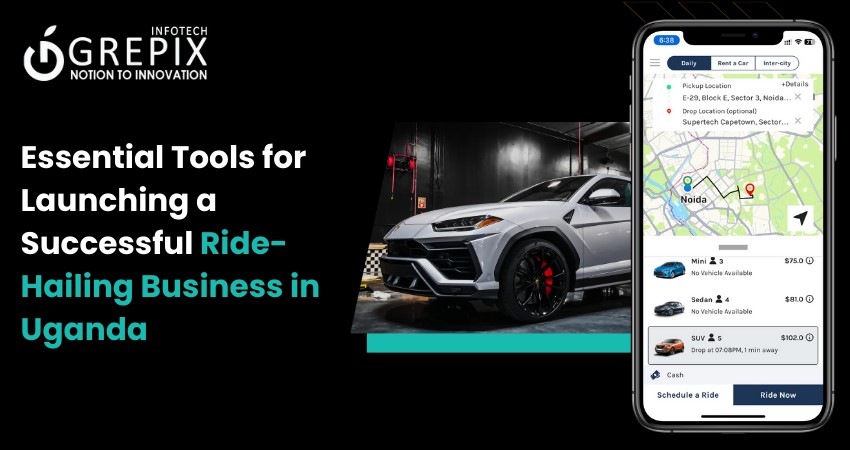Essential Tools for Launching a Successful Ride-Hailing Business in Uganda
The buzz is undeniable. Uganda's cities are pulsating with growth, its population is increasingly digitally savvy, and the demand for convenient, reliable transportation is skyrocketing. For ambitious startups, entrepreneurs, and dynamic Small and Medium Enterprises (SMEs), the ride-hailing sector in Uganda isn't just an opportunity; it's a frontier brimming with potential. Kampala, Entebbe, Jinja, and beyond – the need for efficient mobility solutions is palpable.
But let's be candid. Launching any tech venture is a marathon, not a sprint. Launching a ride-hailing business, with its complex interplay of real-time logistics, user management, payments, and safety considerations, adds several layers of difficulty. Add the specific nuances of the Ugandan market – from infrastructure quirks to preferred payment methods – and the challenge intensifies. You've got the vision, the drive, and perhaps even the initial funding. But the technical hurdles – the sheer time and cost of developing a robust, scalable, and user-friendly platform from the ground up – can often feel like an insurmountable barrier. Months, potentially years, can evaporate in development cycles, while market dynamics shift and competitors gain ground.
What if there was a way to significantly shorten that runway? What if you could leverage a proven, feature-rich foundation to get your service operational faster, allowing you to focus precious resources on what truly matters: building your brand, acquiring users and drivers, and fine-tuning your operations for the unique Ugandan context?
This is where solutions like Grepix come into play. Grepix offers a powerful white-label taxi app solution designed to act as a launchpad, drastically cutting down development time and complexity. This comprehensive guide will explore how Grepix can be your strategic partner in expediting your Ugandan taxi launch. We'll dive deep into the specific advantages Grepix provides and, crucially, outline the other essential tools and considerations you need to assemble a truly successful and sustainable ride-hailing business in the Pearl of Africa. Get ready to shift your launch into high gear.
Launching a ride-hailing service in Uganda presents immense opportunities but significant hurdles, including development time, costs, market complexities, and competition. Building an app from scratch is resource-intensive. This post explores how startups and SMEs can expedite their launch using Grepix's white-label taxi app solution. Grepix offers a pre-built, customizable, and scalable platform (Rider, Driver, Admin Panel), drastically reducing time-to-market and development expenses. We delve into Uganda's unique market dynamics – rapid urbanization, mobile money proliferation, and infrastructure challenges. Furthermore, we outline the essential toolkit beyond the core app needed for success: robust mapping APIs, integrated local payment gateways (especially Mobile Money), reliable communication tools (SMS/Push), analytics platforms, customer support systems, and targeted marketing strategies. By combining Grepix's accelerated platform with the right operational tools, entrepreneurs can navigate the Ugandan market effectively and build a thriving ride-hailing business faster
1Understanding the Ugandan Ride-Hailing Arena: Opportunity Meets Challenge
Before diving into solutions, let's explore the Ugandan landscape—a market of exciting contrasts and specific considerations for your ride-hailing venture.
1. The Opportunity
- Rapid Urbanization: Uganda boasts one of the highest urbanization rates globally. Cities like Kampala are expanding rapidly, increasing population density and the demand for transport services beyond traditional means
- Growing Digital Penetration:Smartphone usage and internet access are steadily climbing. A tech-savvy younger generation is comfortable using apps for daily needs, including transportation.
- Mobile Money Dominance:Uganda is a leader in mobile money adoption. Services like MTN Mobile Money (MoMo) and Airtel Money are deeply integrated into daily life, offering a readily available and trusted digital payment infrastructure crucial for ride-hailing.
- Need for Reliability & Safety:While Boda Bodas (motorcycle taxis) are ubiquitous, concerns about safety, inconsistent pricing, and reliability persist. App-based services offer perceived improvements in these areas, creating significant user appeal.
- Developing Public Transport: While efforts are ongoing, public transportation infrastructure in many Ugandan cities is still developing, leaving gaps that ride-hailing services can effectively fill, especially for middle-mile and last-mile connectivity
2. The Challenges
- Infrastructure Variances: While improving, internet connectivity can be inconsistent outside major urban centers. Road quality varies, impacting travel times and vehicle maintenance. Accurate mapping data can sometimes be a challenge
- Intense Competition: Established players (like Uber and Bolt) and numerous local Boda Boda apps already operate in Uganda. Differentiation through service quality, pricing, niche focus (e.g., corporate, specific vehicle types), or superior localization is key
- Regulatory Landscape: The regulatory environment for ride-hailing is evolving. Staying compliant with licensing, taxation, and safety standards is crucial but requires ongoing attention.
- Payment Integration Nuances:While mobile money is prevalent, seamless integration requires robust APIs and handling potential transaction failures. Catering to users who still prefer cash necessitates secure cash management features within the app.
- Driver Management:Recruiting, vetting, training, and retaining reliable drivers is a significant operational task. Ensuring fair earnings, safety, and providing support are vital.
- Safety & Security:Ensuring the safety of both riders and drivers is paramount. Features like SOS buttons, ride tracking, driver verification, and incident response protocols are non-negotiable.
Navigating this complex terrain requires agility, local understanding, and, critically, a technological foundation that doesn't bog you down. Building this foundation from scratch is where many startups falter.
2The Build vs. Buy Dilemma: Why Reinventing the Wheel Slows You Down
(Approx. 350 words) Faced with the need for a sophisticated platform, startups often grapple with the "build vs. buy" decision. Building a ride-hailing application suite (Rider App, Driver App, Admin Panel) from the ground up might seem appealing for ultimate control, but the reality is often harsh:
- Time Consuming: Developing, testing, and refining a stable, feature-rich ride-hailing platform can take anywhere from 6 months to well over a year, even with a skilled development team. This is time you're not actively operating or acquiring customers.
- Expensive: The costs associated with hiring experienced developers (iOS, Android, backend), QA testers, UI/UX designers, and project managers add up quickly. Factor in server costs, third-party API fees, and ongoing maintenance, and the investment becomes substantial – often prohibitive for early-stage startups.
- Technical Complexity: Ride-hailing apps involve real-time GPS tracking, complex dispatch algorithms, dynamic pricing models, secure payment processing, robust user management, push notifications, chat functionalities, and intricate reporting. Getting all these elements right is a significant technical feat.
- Scalability Challenges: An app built for a few hundred users might crumble under the load of thousands. Designing for scalability from day one requires deep architectural expertise.
- Maintenance Overhead:Technology evolves rapidly. Operating systems update, APIs change, security threats emerge. A custom-built app requires continuous maintenance and updates, diverting resources from core business growth.
For most startups, entrepreneurs, and SMEs targeting the Ugandan market, the opportunity cost of building from scratch is simply too high. The market won't wait. This is where white-label solutions provide a strategic advantage.
3Grepix: Your Fast-Track Solution for the Ugandan Market
(Approx. 600 words) Grepix emerges as a compelling solution specifically designed to overcome the hurdles of launching a ride-hailing business quickly and efficiently. It's not just about providing code; it's about offering a comprehensive, ready-to-deploy platform that allows you to launch significantly faster than building from scratch.
1. What is Grepix?
Grepix offers a white-label, on-demand taxi booking software solution. This means they provide a pre-built, fully functional platform – encompassing the Rider App, Driver App, and a powerful Admin Panel – which can then be customized and branded as your own. Think of it as acquiring a state-of-the-art vehicle chassis and engine, ready for you to add your custom bodywork, paint job, and interior touches.
2. How Grepix Expedites Your Ugandan Launch:
- Drastically Reduced Time-to-Market: This is the headline benefit. Instead of 6-12+ months of development, launching with Grepix can potentially shrink your timeline to a matter of weeks (depending on customization complexity). Their core platform is already developed, tested, and market-proven. Your focus shifts from core engineering to configuration, branding, and operational setup.
- Significant Cost Savings: By leveraging Grepix's existing infrastructure, you avoid the enormous upfront investment required for custom development. This frees up capital for crucial launch activities like marketing, driver onboarding, and initial operational costs vital in a competitive market like Uganda.
- Comprehensive Core Features: Grepix solutions typically come packed with essential ride-hailing features out-of-the-box:
- Real-Time GPS Tracking: For both riders and drivers.
- Seamless Booking Flow: Easy ride requests, driver matching, and booking confirmations.
- Multiple Vehicle Types: Configure different service levels (Boda Boda, Standard Car, Van, Premium).
- Flexible Pricing: Set base fares, per-kilometer/minute rates, surge pricing, and location-based pricing.
- Secure Payment Integration: Ready to integrate with popular payment gateways, crucially including Mobile Money providers dominant in Uganda (MTN MoMo, Airtel Money), alongside card and cash options.
- Ratings & Reviews: Build trust and maintain service quality.
- In-App Chat/Call: Facilitate communication between riders and drivers.
- SOS/Emergency Features: Enhance safety for users.
- Automated Dispatch System: Efficiently assign rides to the nearest available drivers.
- Robust Admin Panel: Manage drivers, riders, vehicles, fares, commissions, track earnings, view detailed reports, and oversee operations.
Using Grepix means you're not starting from zero. You're starting from a position of strength, leveraging a proven technological foundation to hit the Ugandan ground running.
4Beyond the App: Your Essential Toolkit for Ugandan Ride-Hailing Success
While a robust app platform like Grepix is the engine of your ride-hailing business, it needs a full chassis, wheels, and navigation system to operate effectively in Uganda. Launching successfully requires integrating several other essential tools and systems:
1. Mapping & Geolocation Services:
-
Tool: Google Maps Platform APIs (Maps SDK for Android/iOS, Geocoding API, Directions API, Distance Matrix API)
Why Essential: Accurate location tracking, route calculation, and estimated time of arrival (ETA) are fundamental. Google Maps offers extensive coverage in Uganda, though occasional inaccuracies in less mapped areas exist. Ugandan Consideration: Ensure your chosen solution (or Grepix's integration) handles varying road conditions and potentially less precise addressing systems sometimes found outside central Kampala. Consider exploring local mapping initiatives or OpenStreetMap data as supplementary resources if needed, although Google Maps remains the primary standard. Budget for API usage costs, which can scale with your ride volume.
2. Payment Gateways:
- Tools: Local Mobile Money Aggregators (e.g., Beyonic/MFS Africa, Flutterwave, Yo Payments), potentially international gateways supporting Ugandan Shilling (UGX) if targeting card payments.
- Why Essential:Seamless, secure payment processing is critical. In Uganda, Mobile Money integration is non-negotiable.
- Ugandan Consideration: Prioritize deep integration with MTN Mobile Money and Airtel Money. Ensure the system handles confirmations, potential reversals, and provides clear transaction records. Don't forget robust features for managing cash payments if you offer them, including tracking driver cash balances and commission deductions. Grepix's ability to integrate with these local gateways is a key advantage.
3. Communication Tools (SMS & Push Notifications):
- 1. Tools: SMS Gateway Providers (e.g., Twilio, Africa's Talking, local providers), Push Notification Services (Firebase Cloud Messaging - FCM, Apple Push Notification Service - APNS).
- 2. Why Essential: Reliable communication is vital for OTP verification during signup/login, ride status updates, driver alerts, and promotional messages.
- 3. Ugandan Consideration: SMS is particularly crucial in areas with intermittent data connectivity. Ensure your SMS gateway has reliable delivery rates in Uganda. Push notifications are efficient for users with stable data but have SMS as a fallback. Grepix typically integrates these services.
4. Analytics & Business Intelligence (BI) Platforms:
- Tools: Google Analytics for Mobile Apps, Firebase Analytics, Mixpanel, Amplitude, or even custom dashboards built with tools like Tableau or Power BI connected to your backend database.
- Why Essential: You can't improve what you don't measure. Track Key Performance Indicators (KPIs) like ride requests, completion rates, driver earnings, customer acquisition cost (CAC), user lifetime value (LTV), app usage patterns, and peak hours.
- Ugandan Consideration: Monitor data specific to Uganda – preferred payment methods, popular routes, effectiveness of local marketing campaigns, Boda Boda vs. car usage ratios. Use insights to optimize pricing, driver allocation, and marketing spend. Grepix's admin panel provides core reporting, but integrating dedicated analytics tools offers deeper insights.
5. Customer Support & Helpdesk System:
- Tools: Zendesk, Freshdesk, Intercom, or simpler in-app chat solutions. A dedicated support phone line is also advisable.
- Why Essential: Prompt and effective support is crucial for resolving issues (booking problems, payment disputes, safety concerns) for both riders and drivers.
- Ugandan Consideration: Offer support channels familiar and accessible to Ugandans, potentially including WhatsApp support alongside in-app chat and phone. Ensure support staff understand local nuances and can communicate clearly. Consider offering support in Luganda or other major local languages if feasible.
6. Marketing & Promotion Tools:
- Tools: Social Media Advertising Platforms (Facebook, Instagram), Google Ads, Email Marketing Tools (Mailchimp), Referral Program modules (potentially built into Grepix or as a separate tool).
- Why Essential: Acquiring both riders and drivers requires targeted marketing efforts.
- Ugandan Consideration: Leverage social media heavily. Consider partnerships with local businesses, universities, or event organizers. Offline marketing (flyers, local radio spots) can still be effective. Referral programs incentivizing both riders and drivers are powerful growth drivers. Highlight safety features and reliability in your messaging. Tailor campaigns to specific cities or even neighborhoods.
7. Legal & Compliance:
- Tools/Processes: Driver background check services (partnering with local security firms), digital document management for licenses/insurance, potentially compliance tracking software.
- Why Essential: Adhering to local transport regulations, ensuring driver vetting, and managing insurance are critical for legal operation and building trust.
- Ugandan Consideration: Stay updated on KCCA (Kampala Capital City Authority) and national transport regulations. Ensure clear digital records of driver documents (driving permits, national IDs, vehicle inspections, insurance).
5Synergy: Integrating Grepix with Your Essential Toolkit
(Approx. 150 words) The beauty of a well-designed white-label solution like Grepix is that it's built with integration in mind. It serves as the central hub, but it anticipates the need to connect with these external, essential tools. Grepix typically provides:
- API Access: Allowing seamless data flow between the core platform and third-party services like payment gateways, analytics platforms, or communication tools.
- Configuration Options: Enabling administrators to easily input API keys, set up payment methods, and configure communication templates via the admin panel.
- Customization Potential: For more complex integrations specific to the Ugandan market (e.g., a unique local verification service), Grepix's development team or your own can often build custom connectors.
Choosing Grepix doesn't mean you only get an app; it means you get a foundational platform ready to connect with the broader ecosystem of tools needed to run a modern, data-driven, and customer-centric ride-hailing business specifically tailored for success in Uganda.
-Conclusion
Uganda's ride-hailing market beckons with undeniable promise, driven by urbanization, digital adoption, and a clear need for better transportation solutions. However, the path to launching a successful service is paved with challenges – fierce competition, operational complexities, local market nuances, and the significant hurdle of technology development. Building a platform from scratch consumes critical time and capital, resources that startups and SMEs can ill afford to waste.
Grepix offers a powerful alternative: a strategic shortcut. By leveraging their robust, customizable, and feature-rich white-label taxi app solution, you can slash your time-to-market, conserve capital, and launch with a proven technological foundation. This allows you to redirect your energy and investments towards crucial operational aspects: understanding the Ugandan customer, recruiting and supporting your drivers, navigating regulations, and executing effective marketing strategies.
However, the app alone isn't enough. Success hinges on integrating Grepix with an essential toolkit encompassing reliable mapping, seamless local payment gateways (especially Mobile Money), effective communication channels, insightful analytics, responsive customer support, and targeted marketing. Combining Grepix's accelerated platform with this vital supporting infrastructure gives your Ugandan ride-hailing venture the best possible chance to not just launch, but to thrive, compete effectively, and capture a significant share of this exciting market. The journey starts now – faster.
FAQs
1. How much faster can Grepix help launch my taxi app in Uganda compared to building from scratch?
While custom build times are 6-12+ months, using Grepix's ready platform can potentially reduce launch time to a matter of weeks, depending on your specific customization needs and operational readiness
2. Can Grepix's solution handle Uganda's specific needs like Mobile Money payments and Boda Bodas?
Yes, Grepix platforms are designed for flexibility. They can integrate with essential Ugandan Mobile Money gateways (MTN MoMo, Airtel Money) and allow configuration for various vehicle types, including Boda Bodas, with specific fare structures.
3. What are the main costs involved besides the Grepix solution itself?
Beyond the Grepix license/setup fee, budget for essential tools (mapping APIs, SMS gateways), marketing & advertising, driver onboarding/incentives, potential office space, legal/licensing fees, and initial operational costs.
4. Does Grepix provide ongoing support after the launch?
Reputable white-label providers like Grepix typically offer ongoing technical support packages, including maintenance, updates for OS compatibility, bug fixes, and sometimes feature enhancements.
5. Is the Ugandan ride-hailing market too saturated for a new entrant?
While competitive, there's still room for new players who differentiate effectively. Success depends on factors like superior service quality, niche targeting (e.g., corporate clients, specific regions), competitive pricing, strong driver relations, and excellent localization, all made easier with a faster launch using Grepix.
Looking out to start your own venture like Uber? Try out our HireMe Taxi Uber Clone, the easiest way to kick-start your taxi business.







